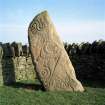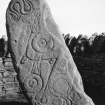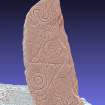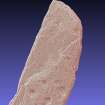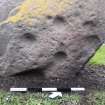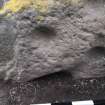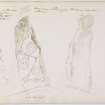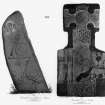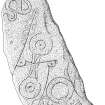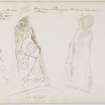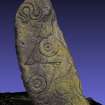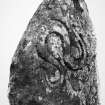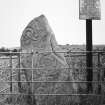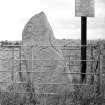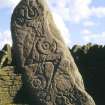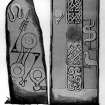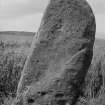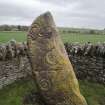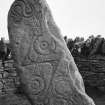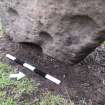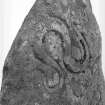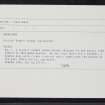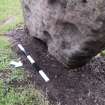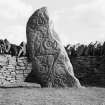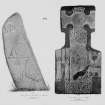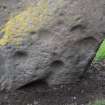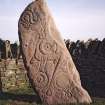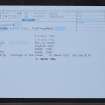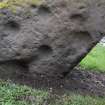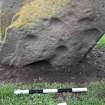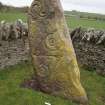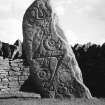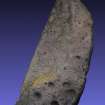Aberlemno 1
Natural Feature (Period Unassigned), Pictish Symbol Stone (Pictish)
Site Name Aberlemno 1
Classification Natural Feature (Period Unassigned), Pictish Symbol Stone (Pictish)
Alternative Name(s) Aberlemno Roadside; Aberlemno No.1
Canmore ID 34861
Site Number NO55NW 8.01
NGR NO 52277 55918
Datum OSGB36 - NGR
Permalink http://canmore.org.uk/site/34861
- Council Angus
- Parish Aberlemno
- Former Region Tayside
- Former District Angus
- Former County Angus
This Pictish Symbol Stone, known as Aberlemno No.1, stands on the south side of the road from Forfar to Brechin, a short distance to the north of Aberlemno church. Dating to about the 7th century AD, it bears three Pictish symbols, usually described as the serpent, the double disc and Z-rod, and the mirror and comb.
Information from RCAHMS (SC, JBS) 7 September 2007
Aberlemno 1, Angus, Pictish symbol stone
Measurements: H 1.88m above ground, W 0.84m, D 0.23m
Stone type: Old Red Sandstone
Place of discovery: NO 52277 55918
Present location: in situ beside the road at Aberlemno.
Evidence for discovery: first recorded by Skene in 1832.
Present condition: weathered.
Description
This slab is incised on one broad face with a serpent above a double-disc and Z-rod above a mirror and single-sided comb.
Date range: seventh century.
Primary references: Skene 1832, 18; Fraser 2008, no 51.1.
Desk-based information compiled by A Ritchie 2017.
Note (1983)
NO55NW 8.01 5227 5591.
A Class I Pictish symbol stone, which stands adjacent to the public road (B 9134) 345m N of Aberlemno church. On one face there are a serpent, a double disc with Z-rod, and a mirror and comb; and near the bottom of the other there are six cup-marks.
RCAHMS 1983.
(Pennant 1774-6, ii, 167; Stuart 1856, 21, plate lxxi; Jervise 1857a, 192; Allen and Anderson 1903, iii, 205; Coutts 1970, 51, no. 1).
Photographic Record (1 September 1999 - 30 September 1999)
Photos taken during a field trip by the Edinburgh University Archaeology Fieldschool.
Magnetometry (9 October 2017 - 10 October 2017)
NO 52277 55918 An area of c1.32ha was surveyed, 9–10 October 2017, using a Bartington 601 magnetic gradiometer in the field adjacent to a group of three Pictish symbol stones at the edge of Aberlemno Village. No features of possible archaeological significance were identified, with a probable metal pipe immediately to the E of the stones indicating this area may be significantly affected by modern groundworks.
Archive: University of Aberdeen
Funder: University of Aberdeen
James O’Driscoll – University of Aberdeen
(Source: DES, Volume 18)
Note (4 May 2021)
Date Fieldwork Started: 04/05/2021
Compiled by: ELF
Location Notes: The panel is located on the S side of the B9134 road surrounded by semicircular stone dyke and interpretation panel 'Aberlemno 1' or the 'Serpent Stone'. It is the furthest E of group of three Pictish Symbol standing stones. It bears Pictish Symbols described as a serpent, double disc and Z-rod , and a mirror and comb on one face On the rear of the stone there are six large circular depressions which have been described as cup-marks. It is commonly thought that the Serpent Stone is a much earlier megalith that was re-used by the Picts. However, the cup-like depressions are not uniform in depth, diameter, or profile. No peck marks or rings are visible. A groove between two of the lowest depressions is wide and flared. All of these depressions are characteristic of natural weathering.









































